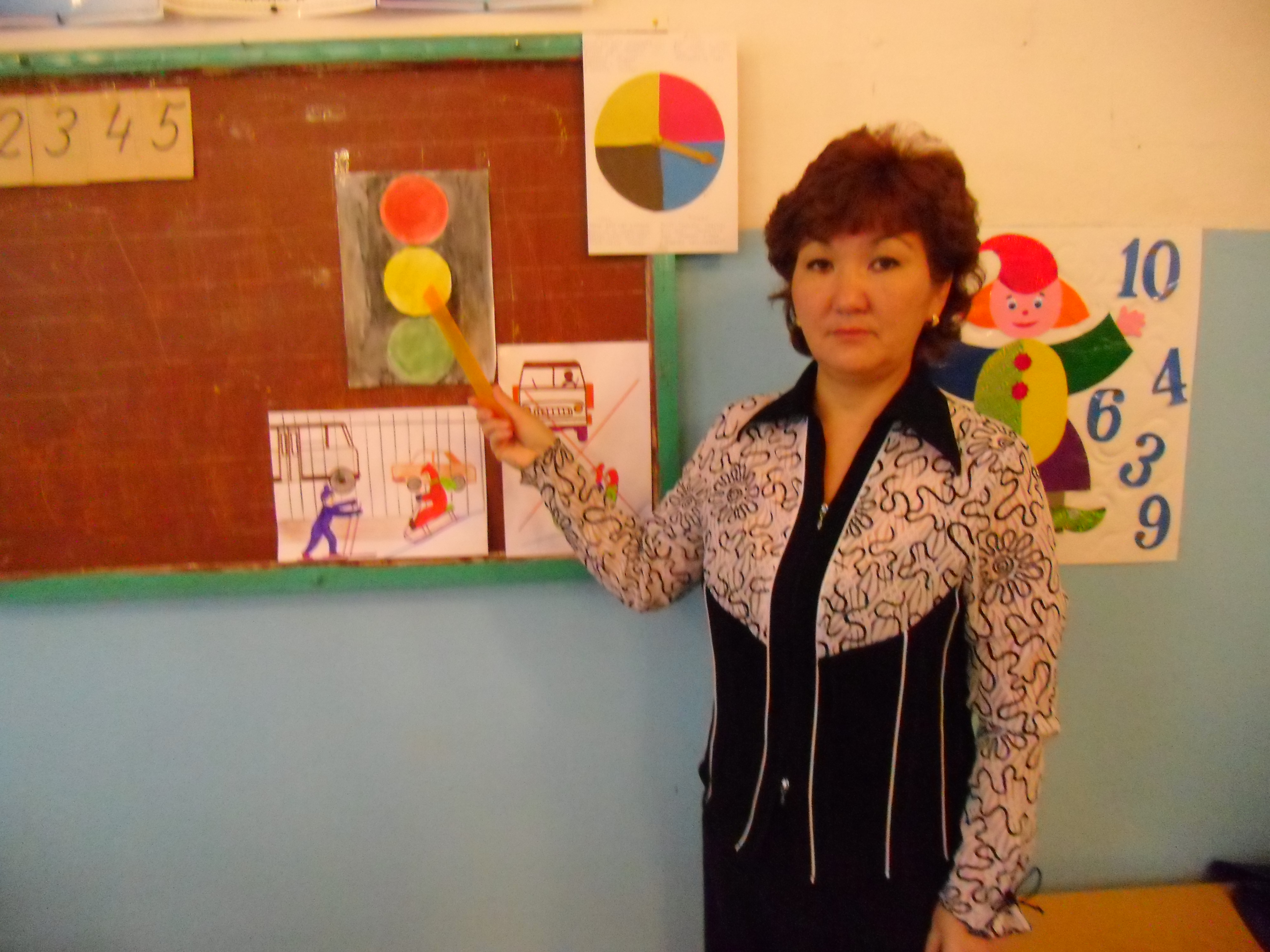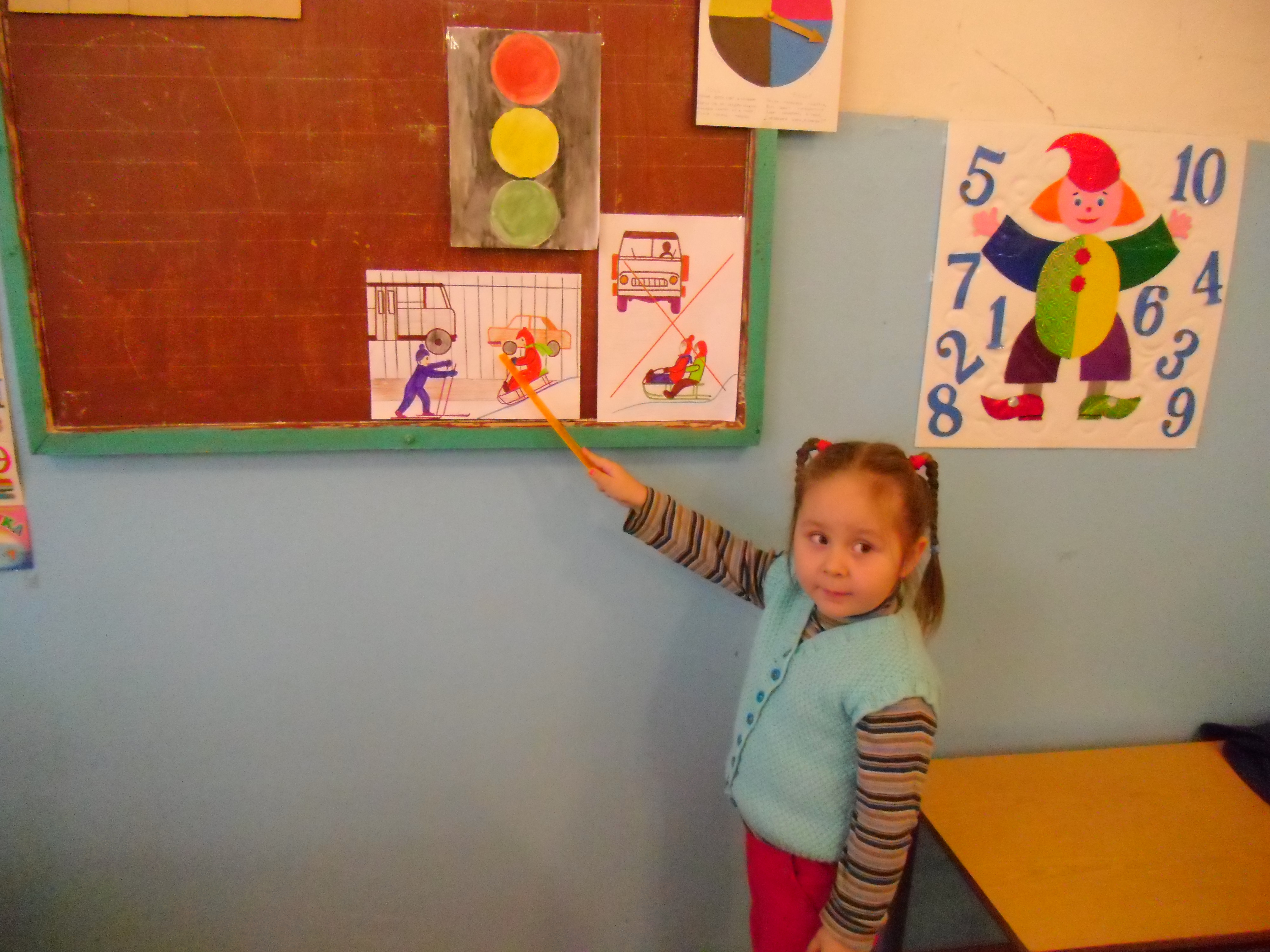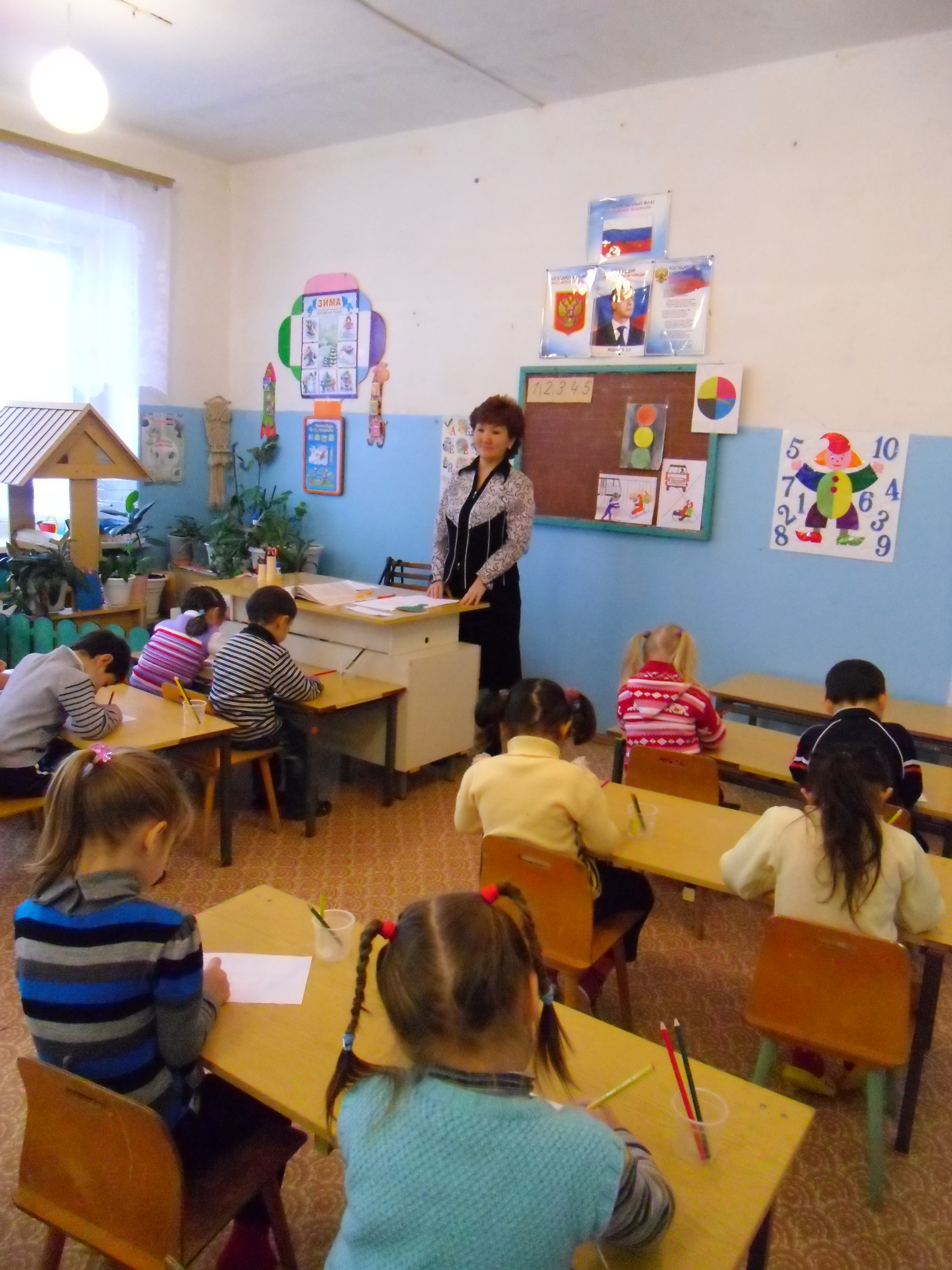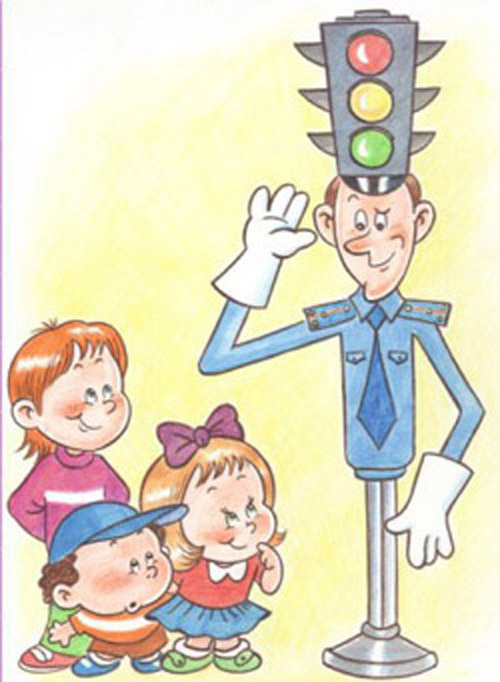The car at the traffic light.
Goal: repeat traffic signals; to introduce the rules of behavior in transport; to learn how to create a plot composition in modeling, to smooth the surface of a fashioned object.
Materials andequipment: plasticine illustration on the topic (traffic light, road, crosswalk, traffic controller, traffic signs)
Class progress
1.Organizational moment. Guessing riddles.
1. A striped horse
Her name is zebra.
But not the one at the zoo,
People are walking on it (crosswalk)
Here stands on the pavement
Tall, strict guard.
He spins, turns his head,
To all passers-by he says:
"The path is now open for you!" (traffic controller)
The game "traffic controller"
3.One leg,
Three eyes. (traffic light) 

4. Along the streets and roads
The soldiers are standing.
We are doing it,
What do they tell us (road signs)
2.JOB.
Look at the pictures and say:
how to portray
crosswalk?

3. Conversation on the rules of conduct on the street.
How to behave on the street?
What street rules do you know?
Do you follow these rules?
Task: look at the picture and determine who behaves on the street
That's right, and who is not?

4.Game "It's me"
The teacher reads poetry, the children answer, "It's me, it's me, it's all my friends" or they are silent.
Which of us goes forward
Only where is the transition?
(Iti, it's me, it's all my friends)
Which of you is rushing soon
What does not see the traffic light?
(children are silent)
How many of you going home
Holds the path along the pavement?
(children are silent)
Who knows that red light
Does that mean no move?
(Itme, it's me, it's all my friends.)
5. The story of the educator about the rules of conduct in transport.
You can not run around the cabin and scream. Do not kick your feet in the seat that is in front of you. Do not press unfamiliar levers and buttons. You can not crowd at the door of a bus or tram. Before entering, first skip those who exit. Do not distract the driver while driving. Do not lean out of the window.
And for passengers too
There are quite a few rules.
Everyone must comply with them.
And do not ride, anyhow!
Gotta go forward
Do not hold people back
Do not stand near the door
Do not interfere with the exit.
And hold onto the handrails
Stand straight, do not grimace.
Senior place to cede-
Seniors need to be respected.
6.Game “It is possible or not”
Children enter the circle. Anyone to whom the teacher will throw the ball and ask a question must say whether this can be done or not.
Is it possible or not?
Play ball on the roadway.
Cross the road with a green traffic light.
Stay out of the window of the tram.
Run on the bus.
Go around the bus from behind.
Bypass the tram in front.
Ride a bike on the carriageway.
7. Creating a story
compositions "Road, traffic light.

The children show the teacher sculpt a long sausage, flatten it, give it a flat road shape.
A toy or fashioned car is installed on the road, a traffic light is nearby. The basis of the traffic light and cars are rectangles and balls.
8. The result of the lesson.
Nina Kondrashkina
Consultation for parents “Safe behavior on the road and in public transport”
The current social and environmental situation in our country society causes concern. We are especially worried about our children. The child finds himself in various situations in which he may just be confused.
We are all educators and parents - trying to answer question: "How to provide safety and health of our children?» . Let's try together to find the answer to it.
What security? This is not just the sum of acquired knowledge, but the ability to behave correctly in various situations, the application of knowledge in practice.
What do you think adults should do to ensure the safety and health of their children?
First, children need the necessary amount of knowledge about generally accepted standards of safe behavior. Secondly, to teach to act adequately, consciously in a given environment, to help preschoolers master elementary skills home behavior, on the street, in the park, in transport. Thirdly, to develop independence and responsibility among preschoolers.
There is a simple pattern: if something is not explained to the child, he will not know this. This applies to everything from math and writing to rules. minibus behavior.
The role of family, mother, father, grandparents, older brothers and sisters in raising a child is difficult to overestimate. From the point of view of the child, everything that they do, especially mom and dad, is right and better. Parents for a child under 7 years old are an example conductand only older children begin to critically evaluate family members behavior. It is under the age of 7 when parents the child is still led along the street by the hand, systematic, everyday training in motion, with a constant personal example of all family members (dad or mom must remind other family members about this) can create positive or negative habits in the rules road behavior. Everyone should remember this when they take the first step on the roadway with the child. the roads.
WHAT SHOULD AND WHAT SHOULD NOT DO BY YOURSELF PARENTS MOVING?
1. Do not rush, go the road always in measured steps.
2. When leaving the roadway, stop talking - the child should get used to that when crossing the roads need to focus.
3. Do not go the road to a red or yellow traffic light, you need to switch only to green light.
4. Proceed only in placesindicated by road sign"Crosswalk".
5. From the bus, trolley, tram, taxi, get out first. Otherwise, the child may fall or run out onto the roadway.
6. Involve your child in your observation of the situation at the road: Show him those cars that are getting ready to turn, drive at high speed, etc.
7. Do not go out with the child because of the car, bushes, without first inspecting the roads, - This is a typical mistake, and children should not be allowed to repeat it.
8. Do not allow children to play near roads and roadway.
9. In the car, be sure to fasten your seat belts; put the child on the very safe place: in the middle or on the right side of the rear seat; during long trips more often stop: the child needs to move.
10. Do not be aggressive towards other road users. Instead, explain to the child specifically what their mistake is. Use different situations to familiarize yourself with the rules. trafficcalmly admit your own mistakes.
Upon leaving home:
If at the entrance transport funds or trees that close the field of vision grow, stop your movement and look around - there is no danger behind the obstacle.
Immediately pay attention to movement transport funds at the entrance and together see if a car, motorcycle, moped, bicycle is approaching you;
When crossing the carriageway parts:
Go over the road only at pedestrian crossings or at crossroads along the marked zebra line, otherwise the child will get used to cross where necessary;
Do not rush and do not run: go the road always in measured steps;
Don't go over oblique way; emphasize, name and tell the child every time that you walk strictly across the street, that this is done for better observation of the car, motorcycle, by vehicles.
Do not go on the roadway due to transport funds or because of bushes, without having previously examined the street; teach your child to do the same;
Take your time to cross over the roadif on the other side you saw friends, relatives, acquaintances, the desired bus or trolley bus. Do not rush and do not run to them, inspire the child that this is dangerous;
Do not start crossing the street, which rarely passes transportwithout looking around. Explain to the child that cars can suddenly leave the alley from the courtyard of the house;
When crossing the carriageway through an unregulated passage in a group of people, teach your child to carefully monitor the start of movement of transportotherwise he may get used to imitate the transition satellite behaviornot observing the movement of transport.
When driving on the sidewalk:
Stick to the right side of the sidewalk;
Do not drive your child around the edge sidewalk: The adult must be on the road side;
Hold the baby tightly by the hand;
Accustom your child, walking along the sidewalk, carefully observe the exit from the yard, etc.
Explain to your child that throwing stones, glass, etc. on the roadway, damage road signs may lead to an accident;
Do not teach your child to go out on the road; carry strollers and sledges with children only on the sidewalk;
When moving a group of children, teach them to mate, following all your instructions or other adults accompanying the children.
Getting ready to go the road:
Stop or slow down, inspect the roadway;
Engage your child in monitoring the situation on the road;
Emphasize your movements: turn your head to inspect the street, stop for inspection the roads, a stop for passing cars;
Teach your child to distinguish approaching vehicles;
Do not stand with the child on the edge of the sidewalk, as when driving transport the product can hook, knock down, run over with the rear wheels;
Pay attention to vehiclepreparing for the turn, tell us about the signals of the direction indicators at the car and the gestures of the motorcyclist and cyclist;
Repeatedly show your child how transport the tool stops at the transition as it moves by inertia.
When driving a car:
Encourage children to sit in the car only in the back seat; do not allow to sit next to the driver if the front seat is not equipped with a special child seat. Explain to them that during a sudden stop or collision, the inertia "Throws" seated forward and he hits the glass of the front panel; this is enough for the passenger to die or be seriously injured;
Do not allow a child to stand in the rear while driving. seat: in the event of a collision or sudden stop, it may fly over the back of the seat and hit the front glass or panel;
Do not allow children to be in the car unattended.
While waiting public transport:
Stand with the children only on the landing sites, and if they are absent, on the sidewalk or curb.
At bus stops of transport hold the baby tightly by the hand. There are frequent cases when a child breaks out and runs out onto the roadway.
When boarding and disembarking public transport(bus, tram and taxi):
You can't get close to the edge the roads during boarding the bus, especially during icy conditions.
Teach your child to be careful in the stopping area - a particularly dangerous place for him: a standing bus reduces visibility roads in this area, pedestrians are often in a hurry here and may accidentally push the child onto the roadway, etc.
Fit to the door transport funds only after its complete stop. A child, like an adult, can stumble and fall under the wheels.
Don't sit in public transport(trolley bus) at the last moment when it is sent (you can be pressed by doors). The front door is particularly dangerous, as you can get under the wheels vehicle;
Parents must enter the vehicleholding a child’s hand.
Ensure that the child holds onto the handrail tightly.
You can not stand at the door - this prevents the exit and entry of passengers.
Do not allow the child to stick his hands and head out in open windows vehicle. Explain to him how dangerous it is.
It is customary to give way to older people, passengers with young children, and people with disabilities.
Go ahead of the child, as the baby may fall, and an older child may run out due to standing transport to the roadway;
Upon exiting of transportholding the baby's hand.
If the pedestrian crossing is located near the bus stop, exiting of transport, parent and the child must wait for his departure and only after that make the transition. Remember: the bus and trolley should be bypassed from behind, the tram in front.
When traveling to public transport:
Teach your child to hold on to the handrails tightly so that when braking he does not get injured from a blow;
Explain to your child what to enter into any kind of transport and you can leave it only when it is completely stopped.
Parents should rememberthat young children without adults must not ride public transport. But gradually, children need to be prepared for this. For example, a child should know his route well, mainly the boarding and disembarking station. He must also know all the landmarks and street names along the route. Explain to the child that he must see and notice everything.
Do not be lazy and do not forget to repeat these rules with your child!
This will help him in the future!
Rules for safe behavior on the road and transport

Rules for safe behavior on the road:
1 . Walk only on the sidewalk, pedestrian or bicycle path, and if not, on the side of the road.
2 . If they are absent, you can move along the edge of the carriageway towards the movement of vehicles.
3 . Where there is a traffic light, you need to go only to the green traffic light.
4. In places where there are no traffic lights, it is safe to cross the road through an underground or elevated pedestrian crossing, or if there is no pedestrian crossing (“zebra”).
5 . If there is no pedestrian crossing, you must go to the nearest intersection. If there is no pedestrian crossing or intersection in the vicinity, we cross the road along the shortest path. And only where the road without fences and is clearly visible in both directions, looking carefully left and right.
6. Do not climb over fences.
7 . If the road is wide, and you did not have time to cross, you can wait on the "island of security."
8. If there are adults nearby, ask them to help you cross the road.
9. Playing games on the road and on the sidewalk is dangerous. It is strictly forbidden to run out onto the roadway due to trees, cars and other objects that prevent the driver from seeing you on time.
10 .Never run onto the road in front of an approaching car. This is dangerous because the driver cannot stop the car immediately.
11 .On the roadway, leave only after making sure that there are no approaching vehicles on both the left and the right.
12 .Do not get out of the bus onto the road. Wait until the bus leaves, and only then, making sure that there are no cars, cross the road.
13. It’s dangerous to ride on skateboards and roller skates.
14. Do not run onto the road outside the pedestrian crossing zone, in this place the driver does not expect pedestrians and will not be able to instantly stop the car.
15. It is dangerous to play ball and other games near the roadway, it is better to do this in the yard or on the playground.
16 . Know how to use a traffic light.

Rules of conduct in public transport:
1 .Bus public transport includes a bus, trolley, tram, metro and taxi.
2. Passengers should not distract drivers while driving.
3 . You must wait for the bus or trolleybus on a special landing site or on the sidewalk.
4 .Entering and leaving the bus and trolley is allowed after a complete stop.
5 . Coming out of the bus or trolley, you need to walk to the pedestrian crossing and cross the road there. It’s better to go to the pedestrian crossing that is behind the vehicle
6 .If older passengers enter the cabin, schoolchildren must give way to them.
Passengers are prohibited from:
1. Open the door of the vehicle.
2 . To protrude into the window openings during its movement.
3 . Prevent closing of vehicle doors.
4 . Throw garbage and other objects that pollute roads and the environment.
Remember!
Only strict observance of the Rules of the road protects us all from the dangers on the road.
Rules for safe behavior on the road and transport
Rules for safe behavior on the road:
1 . Walk only on the sidewalk, pedestrian or bicycle path, and if not, on the side of the road.
2 . If they are absent, you can move along the edge of the carriageway towards the movement of vehicles.
3 . Where there is a traffic light, you need to go only to the green traffic light.
4. In places where there are no traffic lights, it is safe to cross the road through an underground or elevated pedestrian crossing, and if they are absent, a pedestrian crossing (“zebra”).
5 . If there is no pedestrian crossing, you must go to the nearest intersection. If not nearbyno pedestrian crossing, no intersection, we cross the road along the shortest path. And only where the road without fences and is clearly visible in both directions, looking carefully left and right.
6. Do not climb over fences.
7 . If the road is wide, and you did not have time to cross, you can wait on the "island of security."
8. If there are adults nearby, ask them to help you cross the road.
9. Playing games on the road and on the sidewalk is dangerous. It is strictly forbidden to run out onto the roadway due to trees, cars and other objects that prevent the driver from seeing you on time.
10 .Never run onto the road in front of an approaching car. This is dangerous because the driver cannot stop the car immediately.
11 .On the roadway, leave only after making sure that there are no approaching vehicles on both the left and the right.
12 .Do not get out of the bus onto the road. Wait until the bus leaves, and only then, making sure that there are no cars, cross the road.
13. It’s dangerous to ride on skateboards and roller skates.
14. Do not run onto the road outside the pedestrian crossing zone, in this place the driver does not expect pedestrians and will not be able to instantly stop the car.
15. It is dangerous to play ball and other games near the roadway, it is better to do this in the yard or on the playground.
16 . Know how to use a traffic light.

Rules of conduct in public transport:
1 .Bus public transport includes a bus, trolley, tram, metro and taxi.
2. Passengers should not distract drivers while driving.
3 . You must wait for the bus or trolleybus on a special landing site or on the sidewalk.
4 .Entering and leaving the bus and trolley is allowed after a complete stop.
5 . Coming out of the bus or trolley, you need to walk to the pedestrian crossing and cross the road there. It’s better to go to the pedestrian crossing that is behind the vehicle
6 .If older passengers enter the cabin, schoolchildren must give way to them.
Passengers are prohibited from:
1. Open the door of the vehicle.
2 . To protrude into the window openings during its movement.
3 . Prevent vehicle doors from closing.
4 . Throw garbage and other objects that pollute roads and the environment.
Remember!
Only strict observance of the Rules of the road protects us all from the dangers on the road.


